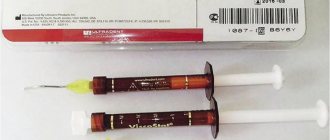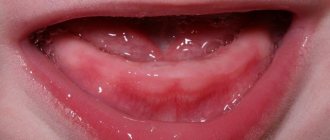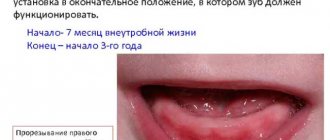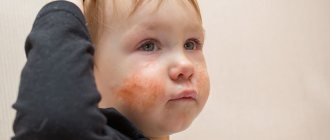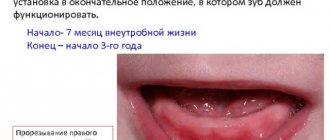Teething order
Is your baby about to turn 6 months old and are you noticing some anxiety in his behavior? This is natural, because the time of teething comes. And this is a difficult period in a child’s life.
The timing of teething in children can vary widely. Normally, the first teeth begin to appear closer to 6 months.
But it happens that baby teeth erupt earlier or much later. And there is nothing terrible here; this process is associated with the constitutional characteristics of the child.
- If you follow the pattern of teething in children, the central incisors on the lower jaw appear first. This usually occurs at 6-10 months.
- The upper central incisors appear at 8-12 months, and the first molars at 13-19 months.
- The canines “wake up” last – by 16-22 months.
- By the age of 2, a child usually already has 20 teeth, and from 6 to 12 years, baby teeth are gradually replaced by permanent teeth.
- Wisdom teeth do not have a milky version and appear in late adolescence.
Constipation is rare before 6 months
Usually, parents of babies in the first months of life are concerned about the opposite of constipation - too frequent bowel movements. But in a baby, regardless of whether he is fed breast milk or formula, the intestines should work exactly like this - in a mode that is considered diarrhea for older children and adults.
There should be no other option, at least until complementary feeding is introduced at 4–6 months. After all, the baby receives mostly liquid food, the waste of which has the same consistency and leaves the intestines without encountering any obstacles on the way - the baby has not yet learned to control the sphincter, which restrains the release of feces.
The baby’s intestines have just begun to “get acquainted” with microorganisms that come from the mother’s milk, from her skin (the baby licks the nipple), and from the environment. Not all new “partners” are accepted: there are some who are rejected, who don’t take root, and so on. Inspection and rejection are accompanied by loose, unstable stools.
Too frequent bowel cleansing does not need correction or treatment if the child is gaining weight and developing correctly. Normal appetite and sleep, gas, absence of fever and other signs of illness indicate that parents have nothing to worry about. If the baby’s mother, tired of changing diapers 10 times in one day, wants to change the situation and asks the doctor to prescribe strengthening medications for the baby, then, without wanting to, she will doom her baby to chronic constipation.
Teeth from birth? It happens
In exceptional cases, children are born with teeth. As a rule, we are talking about the lower incisors. They are called (neo)natal teeth. They erupt within 30 days. Their root is mobile, not formed, and often such teeth quickly fall out.
This feature is fixed genetically - as a rule, the parents had the same thing, a characteristic picture is observed in the baby’s brothers and sisters. Doctors suggest removing such teeth to prevent them from entering the respiratory tract. But this is not a mandatory procedure, at the discretion of the parents.
Constipation after introducing complementary foods
The baby is growing, improving his skills, and it’s time to introduce him to new foods. These circumstances, on the one hand, help to establish peristalsis, and on the other, increase the risk of constipation.
By six months, the baby is already trying to control bowel movements, because he has realized that unpleasant sensations appear after it - itching, burning and other discomfort in the areas where feces fall. In order not to experience discomfort, the child tries to restrain the urge. At first he fails to do this, because the rectum has already learned to work - to reflexively contract and push out waste. And after a couple of months everything works out, the baby wins and starts on the path leading to chronic constipation. To take the child beyond this vicious circle, the mother must minimize the duration of contact of the baby’s skin with feces and expand his diet by introducing complementary foods.
Proteins, fats and carbohydrates included in foods are absorbed in the small intestine, but do not reach the large intestine, where feces are formed. The same cannot be said about fiber. While the baby drinks breast milk or formula, this component of the dish is unfamiliar to him. Even if a nursing woman herself eats a lot of plant foods, the baby gets nothing. Fiber, as already noted, is not absorbed in the intestines, does not enter the blood, which means it is not in breast milk. For the first time, the baby receives fiber with complementary foods, trying his first 25 grams of pureed zucchini, carrots and other vegetables. Plant fibers literally attract all waste, resulting in the formation of feces, which help the intestines master proper peristalsis. In this section of the gastrointestinal tract, in the intestines, there are many muscles, they must learn to consistently contract - tense and relax - in order to squeeze waste out.
The next new product should be introduced a month after the previous one. The new product will likely cause more frequent and loose stools at first. If it is not green and does not foam, there is no need to run to the doctor and ask to prescribe fixatives. Be patient, after a while the innovation will be mastered and bear fruit. Instead of liquid and shapeless yellow-white feces, you will see formed brown feces.
Teething symptoms
The appearance of teeth causes some discomfort in children, which affects their behavior and general condition. In the support chat for the online course “For Every Mom,” we will look in more detail at the main symptoms and means of helping the child and mother. May this period pass as calmly as possible for you.
Teething has accompanying symptoms that will help you understand the cause of these changes:
- Salivation
- Irritation and rash around the mouth
- Change in stool (usually loosening)
- Runny nose
- Temperature increase
- Anxiety
- Moodiness
- Sleep disturbance
This process is not fast. Discomfort may occur several days before gum eruption. If this stage is delayed, they speak of difficult eruption.
There is no reliable information about why the temperature rises during teething in children. It can be assumed that this is a preventive protective reaction of the body. After all, as a result of teething, a tooth creates a wound in the gum, and the body proactively turns on a protective mechanism in the form of inflammation and an increase in temperature. This is necessary to prevent infection of the wound surface...
"Dormikind" for children
Instructions Where to buy Dormikind
Dormikind improves the process of falling asleep and regulates sleep quality (maintaining the sequence of sleep phases, depth of sleep, duration) for the child’s natural activity without daytime sleepiness
Studies have found: Dormikind is comparable in effectiveness in children
- up to 1 year
- from 1 year to 3 years
- from 3 years to 6 years
Dormikind - for any degree of sleep disorders, which manifest themselves as:
- Restless sleep
- Disruption of the circadian rhythm of sleep, the child confuses day with night
- Irritability
- Anxiety, moodiness
- Tearfulness
- Frequent awakenings at night
- Staying awake for long periods of time at night
- Nightmares
Dormikind - for difficulties falling asleep:
- Falling asleep while feeding
- The need for rocking in arms or in a crib
- Sleep onset in parents' bed
- Refusal to sleep in a separate bed
Dormikind can help a child from birth to 6 years:
- The formation of a child's regime
- Gradual weaning of the baby
- Weaning a child off a pacifier/pacifier
- Birth of the next child
- Travel or relocation
- Visiting relatives
- The appearance of the nanny
- Visiting a kindergarten, sports section or creativity club
Dormikind is available in an economical form of 150 tablets. Dormikind is stored for 5 years. 1 package of Domikind means 37 days of use according to the instructions.
Links to sources:
- https://dl.com.ua/uploads/files/2014/8%20(37)/58380712.pdf
- https://www.mediasphera.ru/issues/zhurnal-nevrologii-i-psikhiatrii-im-ss-korsakova-2/2019/7/1199772982019072025/annotation
- https://remedium-nn.ru/?id=7693&download=1
- Miek C. Jong, Lydia Ilyenko, Irina Kholodova, Cynthia Verwer, Julia Burkart, Stephan Weber, Thomas Keller, Petra Klement A Comparative Randomized Controlled Clinical Trial on the Effectiveness, Safety, and Tolerance of a Homeopathic Medicinal Product in Children with Sleep Disorders and Restlessness. Evidence-Based Complementary and Alternative Medicine / 2016 Article ID 9539030, 11 pages, 2016. https://doi.org/10.1155/2016/9539030
- Khachatryan L. G., Pogorelova M. S., Geppe N. A., Lemeshko I. D., Kasanave E. V., Frolkova E. V., Trepilets V. M. Problems of sleep disturbances in young children: issues diagnostics and correction. Journal of Neurology and Psychiatry. S.S. Korsakov. Special issues. 2019;119(7-2):25-32. https://doi.org/10.17116/jnevro201911907225
- Sukhonosova O. Yu., Molochek N. V. Experiment in correcting the symptoms of increased irritability and sleep disturbances in young children. Pediatrics, Obstetrics and Gynecology no. 2, 2009
How to make teething easier
- First of all, it is necessary to remain calm and reassure the child that everything is under control and soon his suffering will end.
- Teething is accompanied by itching in the gums, which forces the child to chew on any hard objects. Provide him with clean and safe teethers - special rings, toys, rags.
- Cold significantly relieves pain and itching in the inflamed gums. You can pre-cool the teether in the freezer, apply ice wrapped in a cloth or bandage for a short time.
In medicine, during teething, special gels are actively used, which are applied to the gums at the site of inflammation: “Cholisal”, “Dentinox”, “Kalgel”... All of them have a local anesthetic effect. And any anesthesia has a detrimental effect on the body, suppressing its defenses.
However, you can ease your child’s suffering while strengthening his immunity. Homeopathy will help you with this. This method is very effective and safe for the baby.
Chamomilla
- A child in the Hamomilla state is capricious and irritable. He kicks, bites, fights, asks to be carried.
- He may demand one toy or another, but having received what he wants, he instantly loses interest in it and throws it away. Malaise is accompanied by outbursts of anger.
- The condition worsens at night, better from motion sickness (in the car, in a stroller). Strong-smelling, green, lumpy stools. A characteristic detail is that one cheek may be red and the other pale. The head sweats profusely, the sweat is hot.
Calcarea carbonica
- Children of this type are well-fed, chubby, but have flabby muscles. During sleep, the Calcarea child's head sweats, especially the back of the head. Sweat has a sour smell.
- These are children with late teething; the teething process itself is long. Such disorders are associated with calcium deficiency, which is poorly absorbed in this constitution.
- Tendency to frequent colds and ear infections. A passionate desire for eggs (especially soft-boiled ones), cheese and milk, as well as sweets is a sure sign of a calcareous child.
- He is worse in cold damp weather, better in warmth.
Homeopathy for babies
Medicines for Infants Dosage: Take 4 -5 granules three or four times a day or, if the pain is very severe, at intervals of half an hour to an hour. If the patient's condition improves, reduce the frequency of dosing: stop taking the medicine when a reliable improvement in the condition is achieved.
| Medicine | Specific indications | Main symptoms | Worse | Better |
| Aconitum narellus Cold | The initial stages of a cold A cold quickly localizes in the chest Sharp sounds when breathing | Sudden onset of symptoms Illness begins after exposure to cold, dry wind | At night In a warm room From lying on the sore side | Outdoors |
| Croup | Hoarse, dry cough Loud, labored breathing Holding the throat when coughing | Motor restlessness! Anxiety, fear | ||
| Diarrhea | Watery stools. Child cries: insomnia. exhibits motor restlessness | |||
| Ear infections | Outer ear swollen, hot, red, painful | |||
| Vomit | From nervous shock or fear Profuse sweating Frequent urination | |||
| Arsenicum album Diarrhea | From spoiled food From excessive consumption of fruit Frequent, dark-colored stools with a foul odor After eating and drinking | Anxiety Weakness Thirst quenched by small sips of water Burning pain | On the right side of the body After midnight From eating and drinking From cold On the sea coast | From the heat From warm drinks |
| Vomit | From spoiled food From excess fruit in the diet After eating and drinking Nausea | |||
| Belladonna atmountain Cold | Sudden strong onset Restlessness Red face, hot and dry skin Feverish state | In the afternoon | In a half-bent position | |
| Ear infection | For a cold head or a wet head Usually the right ear | Red eyes, increased sensitivity to light: pupils are dilated Pulse is firm, strong and rapid | In a lying position From touch From shocks and shaking From noise | |
| Teething | Irritable Delusional state; may bite or hit | |||
| Angina | Throat bright red | |||
| Vomit | From fear From nervousness | |||
| Bryonia alba Cold | Dry and stuffy nose Dry lips Harsh dry cough | Wants to be left alone Irritability; demands something with screams and tears, then refuses what is demanded | ||
| Colic | Worse from motion and heat | Thirst with desire to drink in large quantities | From any movement or movement From touch From heat | In peace In silence |
| Vomit | From fatty foods From high-calorie foods | Constipation with hard to dry stools | ||
| Сalcarea carbonica Colic Teething | Milk intolerance Late teething Poor absorption of calcium by the body | Milk intolerance “Light” complexion, plump Sweating of the head; fontanelles heal late | From any cold or chill From physical or mental stress From wet weather | From lying on your sore side From dry weather |
| Calcarea phosphorica Teething | Late teething | Dark hair and eyes, thin build; fontanelles close late | From damp, cold weather From melting snow | In summer In warm dry weather |
| Calendula officinalis (lotion)For minor cuts and scrapes | Relieves pain Accelerates healing | |||
| For diaper dermatitis | Reduces pain Accelerates healing | |||
| Chamomilla vulgaris Colic | Pulls the legs up towards the stomach. Bloating. | Wants to be carried in arms all the time; one cheek is red, the other is pale. | At night From the heat In the fresh air | When held by adults |
| Diarrhea | Greenish, sticky, mucous stool during teething | Irritability, asks for something, and when he receives it, throws it away | Out of anger | From warm wet weather |
| Ear infections | Very severe pain; the child is beside himself in pain | Insomnia in the presence of drowsiness | ||
| Teething | Irritability Insomnia despite extreme fatigue Diarrhea with greenish stools | |||
| Colocynthis Colic | He doubles over in pain, pulls his legs towards his stomach, presses on his stomach | Abdominal bloating Irritability | From anger From eating or drinking even in minimal quantities | In a double-bent position From heat From firm pressure |
| Diarrhea | Stool resembles jelly Severe cramps A piece of food causes an attack of diarrhea | |||
| Dulcamara Diarrhea | Severe cramps Diarrhea occurs immediately after eating Stools are watery, sticky, with blood, mucus, green in color | Diarrhea occurs after exposure to cold, damp weather Increased sensitivity to cold | At night In cold, damp weather | From external heat From constant movement |
| Ear infection | Stitching pain Buzzing in the ears | |||
| Ferrum phosphoricum Ear infection | Initial stages, before abscesses appear in the ears Throbbing pain | The disease occurs gradually High fever Pale face with red cheeks Anxiety Insomnia | On the right side From touch From movement From shock and shaking | From cold compresses |
| Gelsemium sempervirens Colds, flu | Apathy, detachment, indifference Eyes barely open, heaviness in the eyelids High temperature Chills running up and down the back Soft, vague pulse Lack of thirst Symptoms develop several days after exposure to the factors that caused the disease | At 10 a.m. In wet weather From excitement | In the fresh air From prolonged movement After excessive urination | |
| Hepar sulphuris Cold | Constant discharge Yellow discharge from one nostril Rough breathing Wet, gurgling cough | Sensitivity to drafts Irritability Sweating | In dry cold weather | And damp weather From the heat After eating |
| Ear infection | Stitching pain radiating from throat to ears | |||
| Angina | Stitching pain radiating from throat to ears | |||
| Ipecacuanha Vomiting | After eating Uncontrollable vomiting | Tongue without plaque, clean Constant nausea | From the moist warm wind In a lying position | |
| Magnesia phosphorica Ear pain | Severe neuralgic pain | On the right side of the body From cold At night | From the ashes From the pressure | |
| Mercurius solubilis Cold | Accompanied by diarrhea | More intense salivation than usual Sweating Unpleasant odor Weakness, trembling | At night In humid weather From sweating From lying on the right side In a warm room From the warmth of the bed | |
| Diarrhea | The stool is sticky, with blood, with mucus, greenish in color. A feeling of incomplete bowel movement. | |||
| Angina | Swelling of the cervical glands | |||
| Nux vomica Cold | Nose runs during the day Nasal congestion at night and in the open air | Irritable Belching | At 4 am after eating From touch | In the evening After continuous daytime sleep From firm pressure From humid weather |
| Constipation | Pushing with little result | |||
| Diarrhea | Appears as a result of overeating Strong attempts to defecate with no or little result | |||
| Phosphorus Vomiting | Thirst with desire for cold water, vomiting immediately; as soon as it warms up in the stomach | In the evening From touching From drinking From warm food | From the cold In the fresh air From cold food From sleep | |
| Podophillum peltatum Diarrhea | Occurs after bathing, eating or drinking Uncontrollable urge to defecate Diarrhea contains undigested food Watery | Early morning hot weather Teething | ||
| Pulsatilla nigricans Cold | Used for “mature” colds Thick, creamy discharge that does not irritate the skin of the face | Wants to be outdoors Craves attention Changeable mood Tearful | From the heat After eating | Outdoors From movement From cold applications |
| Constipation | Painful, swollen belly | There is no thirst | ||
| Diarrhea | From overeating Pushing with little or no results | |||
| Ear infection | The outer ear is swollen and red Thick, yellow discharge that does not irritate the skin: foul odor Pain worsened by warmth | |||
| Silicea terra Teething | Painful P0later | Irritability cannot tolerate interference in his affairs Sweaty feet, hands, head and neck Milk intolerance Thin delicate skin Thin sandy hair Lively and quick-witted | In the morning In a position lying on the left side In a lying position From washing From cold | From the warmth From wrapping your head in a blanket |
| Verbascum thapsus Ear infections | Usually in the left ear Decreased hearing | Left-handed remedy | From 9 am to 4 pm From the effort of bathing From temperature changes From talking From sneezing |
Share your interest!
Calcarea phosphorica
- A child in the state of Calcarea phosphorica is fussy, runs somewhere all the time, complains of boredom, whines. He wants to be entertained.
- The teeth of such children appear slowly and late, immediately grow bad and weak, and quickly decay.
- People of this type do not like drafts, they feel worse in the spring, better in dry, warm weather, lying down.
These are the main homeopathic remedies that are suitable for difficult and painful teething in babies. To learn to see the symptoms, understand the processes occurring during illness, be able to select remedies, create your own family homeopathic first aid kit and use it on occasion, we invite everyone to the video course on children’s health “For Every Mother”.
Go to video course
Not according to the rules
And yet, in the first 6 months, constipation in infants is not excluded. They can call him:
- microflora transmitted from mother;
- insufficient fluid volume;
- stress.
Let's say a woman has too many bacteria in her stomach and intestines that produce methane, which causes constipation. They grow rather slowly, ferment, releasing carbon dioxide, which promotes flatulence and bloating. The woman lives with this deviation, has adapted and learned to solve the problem with the intestines in one way or another. Noticing the same thing in the child, she decides that the baby has inherited her characteristics and “saves” him using the same means, making a mistake. Babies should not be given laxatives, especially those containing senna. The baby’s body gets used to such drugs too quickly and can no longer cleanse the intestines without them.
Constipation in a baby under 6 months is also caused by a lack of fluid and hormonal changes. At 6 months, the baby should receive a lot of moisture - approximately 140 ml per kilogram of weight per day. A breastfed baby gains this amount from mother's milk and does not need additional sources of fluid (but only if there is no predisposition to constipation). Little artificial babies are given extra food from the moment they switch to formula.
If a woman is tense or nervous, her level of the stress hormone cortisol increases. The substance enters the baby's body through breast milk, saliva or sweat and also causes constipation.
Even if the mother does not breastfeed, microorganisms that cause constipation sooner or later reach the baby’s gastrointestinal system and produce negative changes in it.

